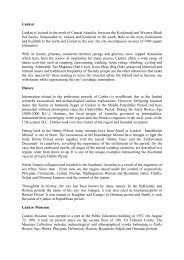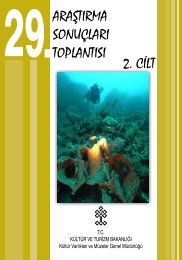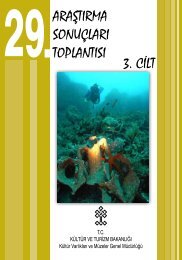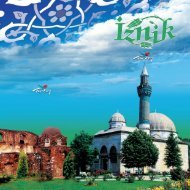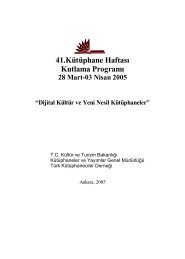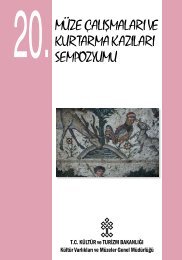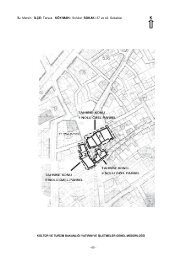PAMUKKALE ingilizce kapak.indd
PAMUKKALE ingilizce kapak.indd
PAMUKKALE ingilizce kapak.indd
You also want an ePaper? Increase the reach of your titles
YUMPU automatically turns print PDFs into web optimized ePapers that Google loves.
<strong>PAMUKKALE</strong>
over the millennia, have also created the unique<br />
travertine formations that resemble nothing so much<br />
as crstallised elds of cotton<br />
Pamukkale and the adjacent ancient city of<br />
Hierapolis are listed as a site of World Heritage<br />
by ogether they form one of the most<br />
attractive destinations in the orld<br />
isit the enchanting and eternal city of Pamukkale<br />
ou ill never forget it
Let us familiarise ourselves with the<br />
History of Pamukkale<br />
he ancient city of Hierapolis, situated km<br />
to the north of Denizli, is known in the annals<br />
of archaeology as the “Sacred City” on account<br />
of its several temples and the other religious<br />
structures clustered in the city ur knowledge<br />
of the city’s early years is limited but it is known<br />
that it was established at the beginning of the nd<br />
century C by umenes , ing of Pergamum he<br />
name Hierapolis honours Hiera, the Queen of the<br />
mazons, beloved wife of elephos, the legendary<br />
founder of Pergamum umenes is also renowned<br />
as the builder of the world famous eus ltar<br />
Hierapolis maintained its authentic fabric by<br />
following the Hellenistic principles of city formation<br />
until the great earthquake that took place during<br />
2
the era of oman mperor ero D he<br />
city suffered greatly in the earthquake and was<br />
completely renovated, assuming the appearance<br />
of a typical oman city ollowing the oman ra,<br />
Hierapolis maintained its position as an important<br />
centre during the yzantine ra Philip the postle<br />
was martyred in the city in D, and the city<br />
became an important centre of Christianity after the<br />
4 th century D<br />
he glorious city was captured by the urks at<br />
the end of the th century t has maintained its<br />
historical texture and the importance of its thermal<br />
waters has never waned<br />
3
he maiet eorahy of Pamukkale<br />
Pamukkale is situated within the territory of<br />
Denizli province, and is one of the most important<br />
destinations in urkey Situated on the southwestern<br />
corner of the Anatolian Peninsula, Denizli provides<br />
passage between Central Anatolia and the coastal<br />
areas of the Aegean and editerranean regions<br />
Pamukkale and the ancient city of Hierapolis are<br />
situated kilometres from the city centre<br />
4
Climate<br />
Part of the inner Aegean Region, Denizli’s climate<br />
differs from that typically found along the Aegean<br />
coast. The mountains of Denizli province run<br />
perpendicular to the coast and the valleys and<br />
plains are open to the sea breeze. Consequently, the<br />
winters are relatively warm and rainy.<br />
Average Monthly Temperatures in Pamukkale<br />
January February March April May June<br />
4.6 6.4 13.4 16.4 20.7 27.1<br />
July August September October November December<br />
29.3 30 23.5 17.2 13.7 8.4<br />
6
How to go?<br />
Pamukkale, part of Denizli province, is accessible<br />
by highway, by railroad, or by air.<br />
Highway: Highway networks provide numerous<br />
routes to Denizli. ntercity coaches stop at a terminal<br />
in the centre of Denizli. Regular minibus service to<br />
Pamukkale departs from the same terminus.<br />
Coach Terminus Tel 4 4<br />
Railroad: There are regular rail connections from<br />
Ankara, stanbul and zmir provinces. The train<br />
station is in the city centre.<br />
Station Tel <br />
Airway: The international airport in ardak county<br />
is situated kilometres outside the county centre<br />
and kilometres from Denizli city centre. There<br />
are twice daily ights to stanbul.<br />
Turkish Airlines fce’s Address stiklal Cad. o<br />
<br />
Airport Tel 4 <br />
7
8<br />
The Astounding, “Must See” Sights<br />
of Pamukkale
Seen from a distance the magnicent Travertine<br />
Terraces of Pamukkale look like the white clouds of<br />
heaven, or a sundrenched, snow covered series of<br />
glittering ridges.<br />
As you approach you realise that water is gently<br />
falling over the clouds of snow. Closer still, as you<br />
wade in ankle deep thermal water, you realise that<br />
this is unlike anything you have seen before and you<br />
are in for a once in a lifetime experience. Let us<br />
share the secrets of Pamukkale, which brings you<br />
in contact with the wondrous, magical architecture<br />
of nature.<br />
Travertine is a sedimentary rock which is formed<br />
under specic conditions as a result of a chemical<br />
reaction. The terraces themselves are the product of<br />
this process. The geological events that have formed<br />
the thermal springs of Pamukkale have also affected<br />
a large region. There are 17 thermal springs in the<br />
region where the water temperatures vary between<br />
and 1C. The thermal spring of Pamukkale is<br />
one of those springs which have been in use since<br />
antiquity, and has provided therapy to humanity<br />
through the millennia. The thermal waters of the<br />
9
spring follow a m long channel to the head<br />
of the travertine ridge and fall into the travertine<br />
terraces, approximately 7 meters long, where<br />
the deposits form.<br />
At the source, the temperature of thermal water<br />
is .C, and it contains a high concentration of<br />
calcium carbonate. When it comes in contact with<br />
the oxygen in the air it forms carbon dioxide and<br />
carbon monoxide gases, which evaporate and leave<br />
deposits of calcium carbonate. nitially, the calcium<br />
carbonate deposits are like soft jelly. ver the<br />
time it hardens and forms the travertine. However,<br />
if visitors are allowed to walk in the cascading<br />
pools, that leads to squashing and dispersing the<br />
soft jelly of calcium carbonate. At present, thermal<br />
water is released over the travertine in a controlled<br />
programme. f a large amount of water is allowed<br />
to ow on a certain area for a long time it leads to<br />
moss formation and darkening of the colour<br />
of the travertine. The atmospheric<br />
conditions, temperature loss<br />
and duration of the ow<br />
affect the creation and<br />
maintenance of pure<br />
whiteness.<br />
10
12<br />
PamukkaleHierapolis,<br />
City of Antiquity
The ancient city of Hiearapolis grew over the thermal<br />
springs and today provides visitors with a glimpse of<br />
the natural gifts of the region and cultural riches that<br />
man added to nature. The ancient city, situated <br />
kilometres north of Denizli, is justly famous for the<br />
buildings and artefacts unearthed during extensive<br />
excavations.<br />
13
Hierapolis was best described by Prof. rancesco<br />
D’Andria who supervised the archaeological<br />
excavations<br />
Pamukkale derives its name, which means<br />
“Cotton Castle”, from the white travertine<br />
deposits formed by thermal springs.<br />
However the travellers of 18 th century,<br />
looking at the graves scattered along the<br />
plain on top of the ridge called it “Pambouk<br />
Kalesi” which means the “Castle of Graves”.<br />
The outstanding natural scenery also<br />
cradles the ruins of Hierapolis of Phrygia,<br />
one of the sacred cities of the East. The<br />
excavations and restitution work carried<br />
out in the recent years have unearthed the<br />
traces of one of the famous centres of Asia<br />
Minor. Every year more than one million<br />
visitors explore the splendour as described<br />
by author A. Aristides in his Oration on<br />
Rome in the 2 nd century AD. The expression<br />
used in the Oration is as follows: ‘ ..., the<br />
whole empire is full of gymnasia, fountains,<br />
temples, workshops, and schools … cities<br />
glisten with radiance and charm, ...’<br />
14
Theatre of Hierapolis<br />
Domitian Gate
PamukkaleHierapolis,<br />
City of Antiquity in its<br />
Heyday (2 nd -3 rd c. AD<br />
17
18<br />
Hierapolis is known as the “Sacred City” on account<br />
of its many temples and religious buildings. The<br />
geographers of antiquity, Strabo and Ptolemy,<br />
claimed that Hierapolis was a Phrygian city,<br />
because of its proximity to Laodicea on the Lycus<br />
and Tripolis, cities situated on the border with the<br />
Caria region. xperts noted that there were human<br />
settlements associated with the cult of Cybele, the<br />
goddess of motherhood, on the site of the city before<br />
it was established as Hierapolis.
Bear Witness to the<br />
Splendour of the<br />
Architecture of Hierapolis<br />
Frontinus Road<br />
14 meters wide, rontinus Road, built in the 1st<br />
Century AD, was the main thoroughfare of the city.<br />
Along its centre is the main drain of the city, covered<br />
with large stone slabs. Shops, houses and warehouses<br />
ran along both sides of the road, forming the city’s<br />
commercial district, which extends along the 17<br />
metres section of the road up to the yzantine Gate.<br />
20
Agora<br />
ollowing an earthquake that shook the city in AD,<br />
this location, which previously contained dwellings,<br />
workshops and the necropolis, was rebuilt as the<br />
Commercial Agora of Hierapolis. xcavations have<br />
22
unearthed ceramic kilns with round plan furnaces<br />
and embossed pots from the nd century BC to the<br />
1st century AD. The built area was 17 metres wide<br />
and metres long, and it was one of the largest<br />
agorae of Asia inor. The site has been restored to<br />
its present state through excavations and is open to<br />
visitors.<br />
23
North Byzantine Gate<br />
During the Byzantine Period, the North Gate, part<br />
of the walls of Hierapolis, was the monumental<br />
entrance to the city. Built in the 4th century AD, the<br />
gate was constructed in symmetry with the South<br />
Gate, with material collected from earlier structures.<br />
The gate was supported by two squareplan towers,<br />
and the arch built over the load bearing architrave<br />
was adorned with a cross. Two pairs of large brackets<br />
anking the entrance are among the impressive<br />
structures that have survived to our times. Sculptures<br />
in the brackets showed the terrifying heads of a lion,<br />
a panther, and the mythological Gorgon, whose<br />
stony gaze and hair with snakes protruding wildly<br />
protected Hierapolis from evil.<br />
South Byzantine Gate<br />
This 4th century AD gate was built with material<br />
reused from demolished structures, and consisted<br />
of harmonious travertine and marble blocks. The<br />
gate was anked by two square plan towers and a<br />
relieving arch reduced the weight.<br />
24 South Byzantine Gate
Gymnasium<br />
The gymnasium dates to the same period of<br />
construction as the Temple of Apollo and the rontinus<br />
Road, following the devastating earthquake in the<br />
1st century AD. Scientic explorations noted a piece<br />
of architrave containing an inscription indicating<br />
that the colonnaded building was a gymnasium. The<br />
building must have consisted of a large courtyard<br />
enclosed with a portico pedestrian walkway. The<br />
building’s date is suggested by the consistency of<br />
architectural features with other buildings built in<br />
Hierapolis in the 1st century AD.<br />
Monumental Fountain with Triton<br />
Monumental Fountain with Triton<br />
This is one of the two monumental fountains built<br />
in the city in the rst half of the rd century AD.<br />
The structure consists of a 7 metre long pool and<br />
two niches for displaying statues. The fountain was<br />
named for Triton, who according to mythology was<br />
the son of Poseidon and Amphitrite, the God and<br />
Goddess of the Sea. Triton was typically represented<br />
as a merman, having the upper body of a human<br />
and the tail of a sh. He was occasionally given the<br />
front legs and hooves of a horse. Archaeological<br />
explorations have recovered the slabs forming the<br />
architectural structure that had fallen into the pool<br />
which contained a decorative frieze. The most<br />
noteworthy of these is the block containing the<br />
depiction of the “Amazonomachy” (Battle with the<br />
Amazons and the relief of the “personied springs<br />
and rivers”.<br />
25
Latrine<br />
The latrine is noteworthy among the architectural<br />
structures of Hierapolis as it has survived with all<br />
its integral features intact, despite having collapsed<br />
in an earthquake. The building has a long and<br />
narrow plan, with entry by two doors on the side.<br />
It was built with travertine blocs and its aesthetics is<br />
derived from its unity of form and function. There is<br />
a channel on the oor carrying waste water to the<br />
26
sewers under the road. Along the internal wall there<br />
is a platform containing seats and slits, and there<br />
is a fresh water channel along the front of the seats<br />
intended for cleansing.<br />
27
House with onic Column Capitals<br />
This architecturally impressive house is situated<br />
on the secondary road leading to the Theatre.<br />
The slender Ionic columns, built in marble, stand<br />
gloriously tall. The nd century house is thought<br />
to have been owned by an aristocratic family.<br />
Substantial renovations were conducted on the<br />
house in the 4th century AD, and a chamber for<br />
visitors was added. The preByzantine inscription on<br />
the wall is considered very important. According to<br />
scientic studies the inscription contains a Biblical<br />
text. The house was collapsed in an earthquake in<br />
the rst half of the 7th century; however its remains<br />
still attract visitors.<br />
28<br />
ater Channels and Nymphaea<br />
The two aqueducts that have provided drinking<br />
water to the city are consisted of channels built<br />
in the hills. The North Channel (coming between<br />
Pamukkale and arahayt and the ast Channel<br />
(from the direction of Gzelpnar merge at a lter<br />
room built on a hill to the east of the city. After<br />
ltration, water was distributed by terracotta pipes<br />
to the streets and houses of the city.<br />
Plutonium<br />
The entrance to the Plutonium is on the right side<br />
of the Temple and it was marked with a marble<br />
niche decorated with seashells. A round, 1st century<br />
pediment highlighting the sacredness of the venue<br />
was placed over the entrance. The podium of the<br />
structure is decorated with the motif of spiralling<br />
branch. The sounds of subterranean sources could<br />
be heard at the entrance of Plutonium. As poisonous<br />
gases accumulate under the threshold, this historical<br />
structure is closed off.
Sacred Area of Apollo<br />
Sacred Area of Apollo<br />
The stupendous sacred area of Hierapolis is devoted<br />
to Apollo, the most important god of the city. Apollo<br />
was the Sun God, and also represented the ne<br />
arts. His father was eus, ing of the Gods, and<br />
his mother Leto. The monumental building dates<br />
to the 1st century AD and was extensively altered<br />
in the rd century AD. The sacred areas built upon<br />
terraces were connected with a marble stairway. The<br />
lower terrace is surrounded by marble columns. n<br />
the podium, an enclosure created by the peribolos<br />
walls used to be thought of as a temple, but was<br />
later recognised as a centre of oracles. The sources<br />
of antiquity told that a poisonous gas was emitted<br />
from the centre of the structure. The Great Temple<br />
of Apollo is noteworthy for its Ionic order. The<br />
foundations of what was described as the ‘Central<br />
Sacred Area’ are visible. The latest studies indicate<br />
that there is a third structure to the north.
Theatre of Hiearapolis
Theatre<br />
The majestic Theatre of Hierapolis was built in the<br />
rd century AD during the reign of Emperor Septimus<br />
Severus, and was used until the late Roman Period.<br />
A special seating arrangement in an exedra for the<br />
notables of the city features seats with highback<br />
and legs ending in lion’s paw feet. n the podium<br />
there is a decorated frieze devoted to Apollo and<br />
Artemis. The theatre’s acoustic arrangement is still<br />
remarkable and the building is one of the most<br />
visited structures of the city.<br />
City Walls<br />
As a result of a law promulgated in AD,<br />
Hierapolis, like other Roman cities, was surrounded<br />
by city walls. The walls, only a small portion of<br />
which survive, used to extend north, south and east,<br />
and was strengthened by 4 square plan towers. In<br />
addition to the north and south monumental gates<br />
of the main road, there were two smaller gates on<br />
the city walls.<br />
City Walls<br />
32
St. Philippe Martyrion<br />
St. Philippe artyrion<br />
This th century church, which housed the remains<br />
of St. Phillippe, who was martyred in the city, is the<br />
most important cult structure in Hierapolis from the<br />
Christian era. The architects who were commissioned<br />
to build the church had already completed the<br />
magnicent palace in Constantinople, and for the<br />
church of St. Phillippe they created an ingenious<br />
design based on the symbolic importance of the<br />
number eight. Eight rectangular structures open<br />
onto a central, octagonal space. rnaments are<br />
themselves laid on octagonal marble panels, and<br />
roundels on the travertine blocks bear the symbols<br />
of Christianity. The whole church structure was set<br />
on a rectangular plan and rooms ran along the<br />
edges of the rectangle.<br />
Pillared Church<br />
The church in the centre of Hierapolis, where the<br />
rst representative of the young religion was Philip<br />
the Apostle, was built in the 7th century AD. The<br />
structure with its three naves is very impressive. The<br />
religious importance of Hierapolis in the Byzantine<br />
era is indicated by the presence of a second three<br />
nave church in the city centre and a single apse<br />
church to the north.<br />
33
Necropolis<br />
There are two necropolis elds containing graves,<br />
one is situated straddling the north road (leading to<br />
TripolisSardes and the other south road (leading to<br />
LaodiceaCollosae. The funeral monuments of the<br />
ancient city are sarcophagi, tumuli, and remarkable<br />
houseshaped graves. While the sarcophagi are<br />
mostly made of marble, other tombs are made of<br />
limestone.<br />
34
Domitian Gate<br />
Domitian Gate (Frontinus Gate<br />
This interesting and well preserved structure<br />
situated at the north entrance to Hierapolis is a gate<br />
with three arches supported by two side towers. It<br />
was built in AD and dedicated to Emperor<br />
Domitian.<br />
Ruins of Medieval Seljuk Fortress<br />
The fortress consists of an extensive wall system built<br />
on a strategic position at a plateau commanding the<br />
valley. The walls were built with reused material<br />
collected from the ruined city, including marble<br />
blocks, some containing inscriptions. During the<br />
excavation conducted in one of the bastions various<br />
architectural artefacts were unearthed. A coin found<br />
at the site indicates, along with other factors, that<br />
the fortress was built between the th and 1th<br />
centuries.<br />
35
Bathhouse Basilica<br />
Bathhouse Basilica<br />
The bathhouse, originally constructed in the rd<br />
century AD was rebuilt as a three nave basilica in<br />
the th century. The experts state that three domes<br />
replaced the groin vault of the bathhouse.<br />
Cathedral<br />
The th century cathedral is considered one of the<br />
most important religious structures of Hierapolis.<br />
The structure contained a baptistery, baptismal font,<br />
space for priests and bishops prayers and women’s<br />
seating area. nly parts of the structure survive, but<br />
the cathedral remains one of the most visited sites<br />
in the city.<br />
Great Comple of Bathhouse Roman<br />
Baths<br />
The impressive structure built over a large area<br />
is a typical Roman Bathhouse, or Thermae. The<br />
structure’s architectural features indicate that it<br />
was built in the nd century AD. After the entrance<br />
there is a large courtyard followed by a rectangular<br />
hall anked by two large halls. Next is the actual<br />
bath structure. Remarkably, the two anking halls<br />
were devoted to the Emperor and ceremonies. The<br />
structure attached to the large hall is now used as<br />
the museum, and is open to the public.<br />
36
Great Complex of Bathhouse Roman Baths<br />
37
Hierapolis Archaeology<br />
Museum<br />
38<br />
The Roman Bathhouse, with its three covered<br />
spaces, the library attached to its east wall, and<br />
the open air gymnasium, was one of the largest<br />
structures in Hierapolis. Its size and state of<br />
preservation inspired the creation of the Hierapolis<br />
Archaeology useum (14. The museum in<br />
its impressive historical building and with its rich<br />
collections exhibits artefacts recovered from the<br />
excavations at Beycesultan Hy (earth mound<br />
as well as the cities built along the valley of the<br />
Lycus River such as Hierapolis, Tripolis, Attuda,<br />
Laodicea. The artefacts from Caria, Psidia and<br />
Lydia regions are also important parts<br />
of museum collection.<br />
Let us familiarise<br />
ourselves with the three<br />
halls of the museum<br />
which house<br />
an impressive<br />
collection<br />
The hall known as the<br />
‘Tombs and Statues<br />
Gallery’ displays the<br />
artefacts unearthed<br />
during the<br />
archaeological<br />
excavations of<br />
Hierapolis and<br />
Laodicea. The<br />
sculptures from<br />
Roman Period<br />
such as Tyche,<br />
the Priestess of<br />
Isis, Dionysus,<br />
Asclepius and
Pan have a striking beauty. The Sidemarastyle<br />
sarcophagus found in Laodicea has been described<br />
as the most spectacular artefact of the museum.<br />
Also the sarcophagus of Maximillian, which<br />
contains an inscription plaque, and several other<br />
gravestones and inscriptions are also attractions.<br />
The ‘Small Artefacts Gallery’ displays several<br />
impressive smaller artefacts laying bare the features<br />
of the civilisations of the 4th century BC. There are<br />
interesting idols, terracotta water jugs, ceremonial<br />
pots, and stone artefacts that were found in the<br />
Beycesultan mound. il lamps, glassware, metal<br />
jewellery, pendants and necklaces, and offering<br />
pots from Phrygian, Hellenistic eras as well as<br />
Roman and Byzantine periods are on public display.<br />
The remarkable coin collection contains several<br />
examples of golden, silver and bronze coins minted<br />
in a long period starting from the 6th century BC.<br />
The ‘Theatre Ruins Gallery’ is a glorious space<br />
containing artefacts with impressive stories. Several<br />
marvellous decorations that once adorned the<br />
stage structure of the Hierapolis Theatre have been<br />
restored and are on public display. Inscriptions<br />
39
describing the coronation of the Goddess of<br />
Hierapolis and resolution of the Theatre Council<br />
are among the noteworthy artefacts. The reliefs<br />
depicting mythologies have impressive aesthetics<br />
and stories. The gallery displaying the statues of<br />
gods and goddesses and a theatrical actor offers<br />
visitors an atmosphere of ancient times.<br />
40<br />
Statue of the Goddess Athena
Museum Garden<br />
Reliefs<br />
Treasure of Trlbey (1 th c. AD
ind Healing at the Thermal<br />
Springs of Pamukkale<br />
The thermal water that has created<br />
the travertine over the ages also made<br />
Pamukkale a unique destination for visitors<br />
seeking treatment in spas and hot springs.<br />
The geographical region of Pamukkale is enriched<br />
by the thermal springs of the rksu (Lycus alley.<br />
The thermal waters have been used as a cure for<br />
thousands of years, and many thermal bathhouses,<br />
both functional and magnicent, have sprung up in<br />
the locale.<br />
In Roman Period, the fame of the thermal waters of<br />
Hierapolis was widespread, and the city was visited<br />
by cureseekers from across the Empire. With its<br />
thermal baths the city became a medical centre and<br />
provisions were made for visitors who stayed there<br />
for their short or long term treatment. Numerous<br />
graves in the Roman necropolis attest to the lives<br />
of the many people who came seeking a cure and<br />
stayed until the end. During antiquity religious<br />
ceremonies were held around the thermal springs,<br />
and popular festivals were organised as the city<br />
became the preferred treatment centre for notable<br />
and rich people. Studies indicate that treatments<br />
were supervised by both ministers of religion and<br />
doctors.<br />
42
46<br />
Among the buildings that have survived to the present<br />
day are the Nymphaeum (fountain from antiquity<br />
and Roman bathhouses, glorious structures built for<br />
the benet of those who sought the thermal waters.<br />
Today swimming in the pools of thermal waters<br />
amid the ruins and historical structures of Hierapolis<br />
city is an enjoyable privilege. When the calcium<br />
carbonate containing waters rising through the karst<br />
topography to the surface carbon dioxide degasses<br />
and calcium carbonate is deposited gradually<br />
creating the travertine. The calcareous tufa, which<br />
is generally white, looks like bales of cotton piled<br />
up to form the famous Pamukkale travertine. The<br />
therapeutic nature of Pamukkale’s thermal waters<br />
has been recognised since very early ages, and<br />
its medical value was conrmed centuries later.<br />
Pamukkale is listed as a UNESCO World Heritage<br />
Site, and offers several alternative therapies to its<br />
visitors. ollowing a medical evaluation patients are<br />
offered treatments for cardiovascular disorders, high<br />
blood pressure, rheumatism, rickets, paralysis, skin<br />
disorders, eye ailments, nervous system disorders.<br />
Also the thermal spring waters can be drunk warm<br />
as a cure for kidney stones, stomach spasms, urinary<br />
inammations and acts as a natural diuretic.
Pamukkale Cuisine is t<br />
for your palate<br />
The rich cultural life of Denizli is reected in its<br />
unique cuisine. Traditional dishes have been<br />
carefully preserved and visitors are able to taste<br />
the regional cuisine in many quaint or modern<br />
restaurants of Pamukkale. The famous soups of black<br />
47
48<br />
eyed peas, yoghurt and our (ovmaç), and sun dried<br />
yoghurt and tomato (tarhana); meat dishes such as<br />
steam cooked lamb and potatoes (tas kapama);<br />
fried beef served with a vinegar sauce (sirkeli et),<br />
lamb baked in tandoor oven , baked lamb<br />
ribcage lled with spicy rice , baked<br />
lamb’s stomach membrane (omentum stuffed with<br />
a mixture of lamb liver, rice and herbs ,<br />
spicy chicken soup served with a boiled dough<br />
, lamb’s stomach grilled in butter on a hot<br />
plate ; vegetable dishes including<br />
various aubergine dishes including rice stuffed dried<br />
aubergines, and baked aubergines, okra dishes;<br />
salads of boiled blackeyed peas in a garlic sauce<br />
, wheat sprouts with other<br />
greenery mallow (malva vulgaris<br />
salad are the most renowned<br />
dishes of the regional cuisine. Pamukkale also offers<br />
many stuffed breads and pastries. ilo pastry and<br />
the leavened and unleavened atbreads ought to<br />
be tasted. Pastries and deserts made with millet,<br />
hot plate fried wheat, and chestnuts as well as the<br />
delicious regional fruits such as grapes, melons,<br />
and water melons are consumed after dinner. The<br />
local wines are well received across the world and<br />
well suit any dinner enjoyed with a sunset view of<br />
Pamukkale.
Entertainment in Pamukkale<br />
In Pamukkale you can supplement visits to the natural<br />
and cultural riches of the area with enjoyment of the<br />
local entertainment options. The hotels, cafs, night<br />
clubs and other entertainment venues provide you<br />
a large choice.<br />
Accommodation<br />
There are ample and varied facilities for<br />
accommodation matching the unique natural<br />
beauty of the area. No other destination in the world<br />
offers you the opportunity to swim in thermal pools<br />
amid the ruins of antiquity. The thermal facilities<br />
of the hotels are designed for both modern and<br />
traditional services. The resorts provide you with<br />
every convenience, including health and beauty<br />
treatments, mud baths, spas and massage therapy.<br />
The hotels in Pamukkale provide visitors with<br />
comfortable accommodation, while their restaurants<br />
serve the unique dishes of Turkish cuisine. Ample<br />
opportunities exist for entertainment and shopping.<br />
50
Ecursion Options<br />
The earliest image of the Denizli Rooster, which is the<br />
symbol of the city, was found in a 2nd Century AD relief<br />
at the ruins of Laodicea. The unique and sonorous crow<br />
of the Rooster of Denizli accompanies visitors on their<br />
ecursions around the city.<br />
Denizli is situated in the thermal belt of Turkey, a<br />
line of thermal springs passing through Pamukkale,<br />
arahayt, Akky, enicekent and Sarayky, which<br />
provides opportunities for health tourism, and offers<br />
many excursion opportunities in its environs. The<br />
Thermal resorts offer cure facilities as well as superb<br />
accommodation, recreation, entertainment and sports<br />
activities every day of the year.<br />
51
arahayt
Laodicea ad Lycum, established between 6 and 61<br />
BC, is one of the best known ancient cities of Anatolia,<br />
and the site of one of the seven most important churches<br />
of Christianity. It is renowned for its glorious architecture<br />
as well invaluable coins.<br />
Laodicea ad Lycum<br />
54<br />
The ruins of Colossae, which used to be one of<br />
the most important centres for the trade in Greater<br />
Phrygia, are denitely worth a visit.<br />
Tripolis was one of the border cities of Lydia<br />
providing access to Caria and Phrygia regions<br />
and was enriched by commerce and agriculture.<br />
The city had also a religious importance since the<br />
historical sources indicate that it was a bishopric.<br />
The structures, including theatre, bathhouse, city<br />
council building, necropolis, fortress and city walls,<br />
display the architectural aesthetics typical of the<br />
period.
indings from the excavations Tripolis<br />
Relief, Hieron of Heraclea<br />
The city of antiquity devoted to Hercules, Heraclea<br />
Salbace, is situated in the akf illage of Tavas County.<br />
The River Goddess of the city was Timelos, and the<br />
Hieron (sacred eld of Heraclea built by masters form<br />
Aphrodisias is impressive.<br />
Relief, Hieron of Heraclea<br />
55
Ancient City of Eumenia<br />
There are other impressive cities in the environs of Denizli<br />
including Eumenia, which is situated in ivril Ikl, and<br />
was part of the Phrygian region; Appollonia and the<br />
Medet Earth Mound where the rst settlements in the<br />
region, date back to the Bronze Age; Attuda was famous<br />
for its temples dedicated to the Moon God Men; the<br />
cities of Trapezapolis, Dionysopolis and Sebastepolis are<br />
impressive and have their own unique histories.<br />
Ancient City of Attuda<br />
The ancient city of Thabea which was built after the<br />
reign of Alexander the Great, and is noteworthy for the<br />
structures on its acropolis Apollo Lermenos Temple,<br />
which was built by the temple slaves and devoted to the<br />
god Apollo; Beycesultan Mound which is renowned for<br />
56
marble, bronze, ceramic and bone artefacts from the Late<br />
Chalcolithic, Early and Middle Bronze Ages, offer a rich<br />
journey through the layers of history.<br />
indings from the Ancient City of Thabea<br />
Apollo Lermenos Temple<br />
inding from Beycesultan Mound<br />
57
elolan Cave<br />
aklk Cave, one of the most visited sites of the city<br />
environs, has impressive formations of travertine pools,<br />
stalactites and stalagmites. Dodurgalar elolan Cave is a<br />
14 metres long passage style cave which has completed<br />
its development (fossilised. The illuminated stalactites,<br />
stalagmites and columns of the cave provide a visual<br />
festival.<br />
aklk Cave<br />
58
The ecursions to high plateaus (yayla) such as<br />
Sleymanl ayla of Buldan, Tadelen ayla of Babada,<br />
Topuklu ayla of Beyaa, and efe ayla of Serinhisar<br />
are attractive options for visitors. There are specically<br />
designated picnicking and recreational areas with tents<br />
and facilities serving visitors. The Menderes (Meander<br />
River Basin of the province provides rafting facilities for<br />
adventure seekers.<br />
Tadelen Plateau<br />
Topuklu Plateau<br />
59
or those looking for paragliding<br />
options, there are facilities in<br />
Pamukkale, and also at Honaz,<br />
Gktepe and Babada mountains.<br />
or bird watchers, the lakes of Ikl<br />
Gl of ivril, Ac Gl of ardak,<br />
and alt Gl, provide unique<br />
opportunities to observe a varied<br />
range of migrating birds.<br />
ivril Ikl Lake<br />
60<br />
Sakl Lake
ardak Ac Lake<br />
artal Lake
62<br />
The famous wines of Denizli can be found in many of the<br />
shopping centres, and can be tasted at the wineries on the<br />
road to Pamukkale, which are open to public and provide<br />
opportunities to observe the wine making process.
Enjoy Shopping in Pamukkale<br />
Shopping in Pamukkale provides ample<br />
opportunities to choose souvenirs<br />
reecting the rich local culture.<br />
Among offerings are textiles and<br />
hand woven Buldan cloths, at<br />
metal wire embroidery <br />
and silver wire embroidery <br />
, glassware, terracotta jugs and<br />
household items, leather goods and shoes, decorative<br />
copperware, wickerware, combs made traditionally from<br />
bone and horn, dried nuts avoured with various spices,<br />
and traditional clothing items.<br />
Some of the souvenirs in Denizli are leblebi (oven fried<br />
chickpeas of Serinhisar, hand made knives and machetes<br />
of ataan, hand made bespoke shoes, textiles and linens<br />
exported world wide.<br />
63
64<br />
Leblebi (Roasted chickpea)
Car rental services make ecursions easy<br />
Plan your own excursions from Pamukkale by hiring a<br />
car. Numerous car hire agencies and companies provide<br />
comprehensive services.<br />
Do not leave Pamukkale<br />
unless you have<br />
Seen the unique travertine of Pamukkale;<br />
Explored the glorious ancient city of<br />
Hierapolis;<br />
Visited the Hierapolis Archaeology Museum;<br />
Treated yourself at the thermal pools and<br />
springs;<br />
Beautied yourself in the mud baths;<br />
Purchased the eye catching local souvenirs,<br />
And tasted the Pamukkale cuisine...<br />
66
IMPORTANT ADDRESSES AND PHONES<br />
Emergency Phones<br />
Ambulance 11<br />
Health Advice 14<br />
Police 1<br />
Gendarmerie 16<br />
Coast Guard 1<br />
Trafc Information 14<br />
ire brigade 11<br />
orest ire 177<br />
Governorship of Denizli<br />
..6 61 <br />
www.denizli.gov.tr Email denizlidenizli.gov.tr<br />
Municipality<br />
..6 1 7<br />
www.denizli.bel.tr<br />
Email denizlidenizli.bel.tr<br />
Security Directorate<br />
..6 14 <br />
www.denizli.pol.tr<br />
Provincial Directorate of Culture and Tourism<br />
..64 71<br />
www.pamukkale.gov.tr<br />
Tourism Information<br />
..7 77<br />
Association of Hoteliers and Managers of Tourist Resorts<br />
of Denizli (DENTROD<br />
..71 41 6<br />
State Hospital<br />
..6 11<br />
httpdenizlidh.gov.tr<br />
Turkish Airlines<br />
..64 6 61<br />
www.thy.com.tr<br />
Email customerthy.com<br />
Railroad Station<br />
..6 1
Cultural Heritage is Fragile<br />
The world’s cultural heritage is like a big puzzle.<br />
Each monument, each object, is an irreplaceable part<br />
of the overall picture which gives us insight into our<br />
origins, our development and our lives today. It helps<br />
us to understand and appreciate other cultures. Each<br />
discovery, each new interpretation adds to the puzzle<br />
and makes the picture clearer. We must ensure the<br />
protection of every single piece today, so that future<br />
generations may have the opportunities to enjoy the<br />
puzzle.<br />
Many people are not aware that our cultural heritage is<br />
under stress from natural disasters such as earthquakes<br />
and oods, and from slower acting processes such as<br />
pollution or human actions. Even the most innocent<br />
gestures such as collecting ancient pieces of pottery<br />
or mosaics as souvenirs have a destructive impact if<br />
repeated by thousands. Touching an object of stone,<br />
metal or textile leaves traces of grease, acid or sweat<br />
on its surface. Climbing a monument wears down the<br />
structure underneath and can dismantle it. Writing or<br />
engraving names inicts permanent damage. Strolling<br />
around narrow crowded places with bulky bags or<br />
backpacks might knock over an object or scratch a<br />
mural painting and ruin it. There are countless ways<br />
in which one can unknowingly contribute to the<br />
destruction of cultural heritage.<br />
In there will be 1.6 billion visitors per year<br />
worldwide. Let us raise awareness of this issue so that<br />
we may join together to protect and enjoy the diversity<br />
and richness of our cultural heritage.<br />
International Organization for Conservation of<br />
Cultural Heritage (ICCROM<br />
71
REPUBLIC OF TURKEY<br />
MINISTRY OF CULTURE AND TOURISM<br />
General Directorate of Information ©<br />
www.goturkey.com<br />
www.kulturturizm.gov.tr<br />
72<br />
Text Arrangement<br />
Serap ahin<br />
Sources<br />
Denizli Provincial Directorate of Culture and Tourism,<br />
rancesco D’AndriaDnya Mirasnda Trkiye<br />
(Ankara6)<br />
Graphic Design<br />
Asmedya<br />
Tel. 1 46 7 6<br />
www.asmedya.com.tr<br />
Photographs<br />
Adnan Ata, Ahmet uzik, Erdal azc,<br />
ikret zkaplan, unda Gnendik, zzet eribar,<br />
Medya Em, Mehmet Hengirmen, Murat cal,<br />
Orhan Usta, Stk rat,<br />
erafettin Glsaran, cel ifti,<br />
Archive of Denizli Provincial Directorate of Culture<br />
and Tourism,<br />
Archive of the Ministry of Culture and Tourism<br />
Printed by<br />
Baak Matbaaclk ve Tantm Hiz. Ltd. ti.<br />
Tel 1 7 16 17 ax 1 7 7<br />
Ankara, 11 ree of charge
<strong>PAMUKKALE</strong><br />
The healing springs of Pamukkale have cured and<br />
revitalized humanity for thousands of years. The<br />
thermal waters, truly a miracle of nature, not only<br />
embrace mankind with their restorative power, but,<br />
EUROPE<br />
TURKEY


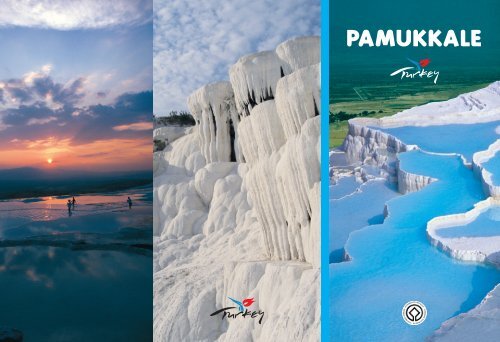
![11. Türk Arkeoloji ve Etnografya Dergisi [2011] - kulturvarliklari.gov.tr](https://img.yumpu.com/50970752/1/182x260/11-turk-arkeoloji-ve-etnografya-dergisi-2011-kulturvarliklarigovtr.jpg?quality=85)
